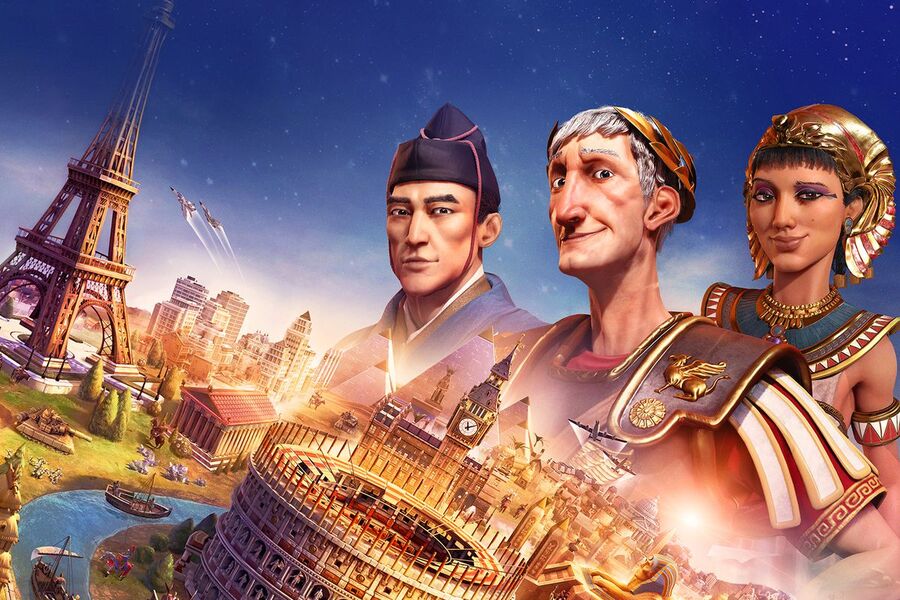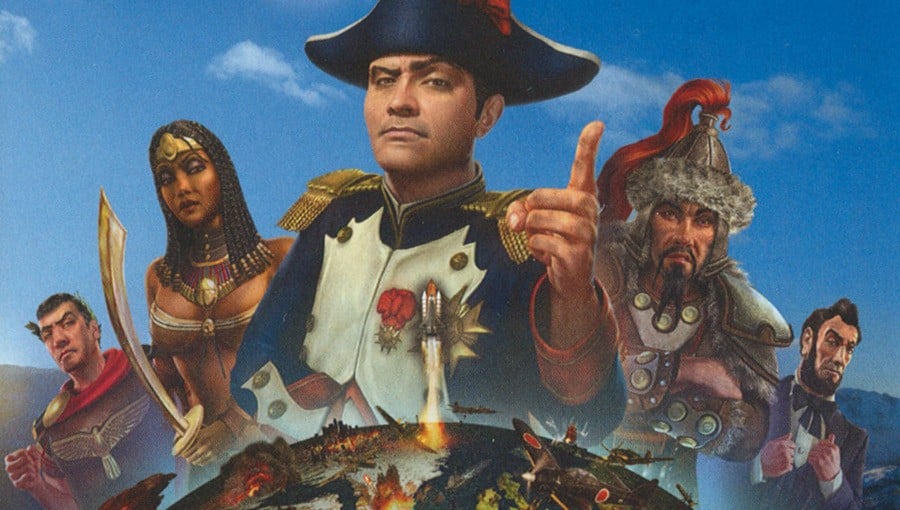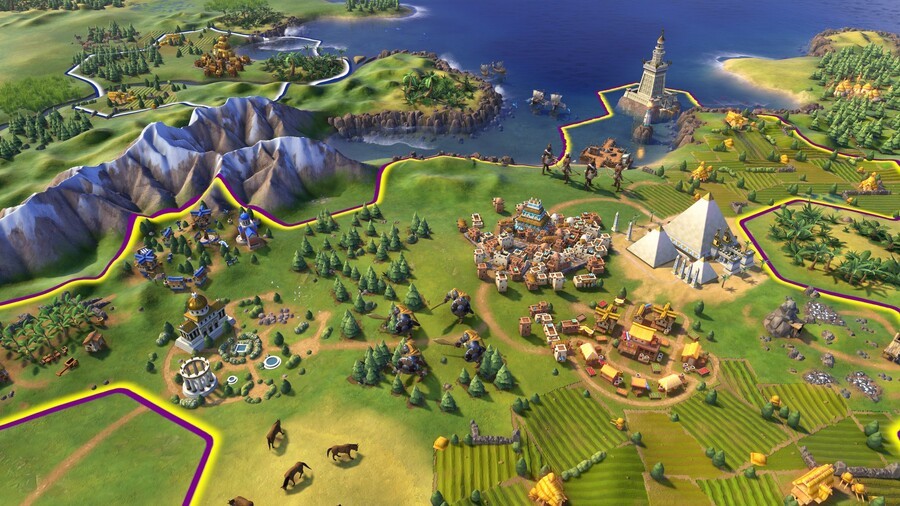
It’s four minutes ‘til bedtime and you’ve got work/class in the morning – time for one more race, one more round, one more turn. We’ve all been there. Before you know it, forty-five minutes have slipped by and your self-imposed time limit has come and gone. And the next, and the next. What’s that strange light bleaching the monitor? Oh, it’s the sun.
If there’s one series which encapsulates this perilous cycle above all others, it’s got to be Civilization; the strategy franchise which made ‘one more turn’ a marketing hashtag. With Sid Meier's Civilization VI arriving on Switch – the first mainline entry to come to a handheld console or Nintendo home platform for twenty-three years – what better time to look back at gaming’s ultimate time-sink?
The Dawn of Civilization
Tired of designing flight sims, MicroProse co-founder Sid Meier decided to branch out when he began programming the original game on IBM PC. Teamed with Bruce Shelley, veteran board game designer, he incorporated ideas from classic turn-based wargame Empire, mixing elements from Risk and the burgeoning genre of simulation and god games exemplified by SimCity and Populous.
His previous title, Railroad Tycoon, showed that players enjoyed building and managing multiple systems at once, and history textbooks provided a natural template for technological growth through the ages. Starting on a randomised land mass in 4000BC, time would move on every turn and your society would develop according to progress unlocked on a tech tree – advancing from the humble wheel to the rocket. With enough time and careful strategy, endgame victory comes by beating other civilisations, either through conquest or winning the space race and launching humanity gloriously into the final frontier.

Released in 1991, Sid Meier’s Civilization (or plain old Civ) became the defining game of the 4X genre (eXplore, eXpand, eXploit and eXterminate), and players quickly discovered it can be your best friend and worst enemy all at once. Randomised elements make every game unique and it’s easy to lose yourself founding settlements, farming resources, negotiating with historical figures – using the pen or sword as necessary – and micro-managing your territories. Real-world days fly by and you feel you’ve barely scratched the surface.
Meier acknowledges the obsessive behaviour his most famous work inspires. “We knew this was more fun than other games, and it wasn’t really fun; there was a compulsion about it that transcended fun,” he commented in a conversation with Soren Johnson, lead designer on Civilization IV. “Your brain is full, I think, when you play Civ […] There’s no room for real life!”
A port found its way to Super Nintendo in 1995, published by Koei. Looking back now, its slow pace and barrage of menus make it a tough recommendation over, well, any other version (although masochists feel free to track down the N-Gage port), but the core remains. It’s rudimentary and cumbersome, but it’s Civ on a SNES.
Stay on the Right Side Of Gandhi
The original’s success led to CivNet in 1995, a multiplayer version allowing competitive play over the then-new-fangled world-wide-web, with a sequel proper arriving the following year. Civ 2 offered refinement, developing areas of trade and diplomacy and shifting from a top-down perspective to a fancy isometric view. Meier briefly flirted with tactical combat for battles but abandoned the idea. Players could consult High Council advisors – actors who’d reappear in each era with costume changes, addressing the camera and bickering with one another.
These amusing videos clips didn’t survive into subsequent entries, but comedy has always played a part in the franchise’s appeal. Civ embraces incongruity, recognising the fun in anachronistic spats between Ramesses and Abe Lincoln, throwing inexplicably immortal leaders together with schoolboy abandon. An infamous bug in the first game (which involved a minus 2 ‘aggression’ value causing an integer rollback from 1 to the maximum possible 255) turned Gandhi, Indian leader and notorious pacifist, into a nuke-toting warmonger, a quirk the series nods to in subsequent entries. The exaggerated caricatures in the latest game reflect that absurdity and playfulness. It’s fun to speak with icons like Alexander, Caesar and Napoleon; to learn their traits, anticipate their responses and get involved in good old-fashioned feuds when diplomacy fails. Beyond mere strategy, Civ fires up your emotions.

The game’s overwhelming popularity led to some intriguing legal entanglements behind the scenes; a lawsuit from Activision, which acquired rights to a 1980 board game of the same name, threatened to bury the series in red tape. Beyond the title and a tech tree, the two games approach empire-building somewhat differently, but MicroProse was conscious enough to licence the name for the original release, and its influence on Meier’s Civ is still a topic of debate and speculation.
Internal shuffling and disagreements led to the Civ team forming a new company, Firaxis. Technically a contractor at MicroProse, Meier maintained decent relations with his former firm, but with a backdrop of lawsuits, countersuits and shenanigans, the Civilization brand was stuck in limbo, so Firaxis’ next version was christened Sid Meier’s Alpha Centauri – a reference to the destination following a space-race victory. Set in the 22nd Century, the Meier brand name helped make this spiritual sequel’s roots explicit and the game was very well received.
Third Time's A Charm
Following a web of litigation, acquisitions and settlements, Firaxis released Civilization III in 2001. It brought borders and Culture to the table, enabling new victory conditions. Changes to Corruption, Waste and Maintenance dissuaded players from simply founding new cities to solve production problems. 2005’s Civilization IV further refined the formula, trimming or removing laborious gameplay elements entirely. The unpopular Pollution system was jettisoned and Religion debuted, along with a greater variety of roles for workers.
As the mainline games grew more complex, spin-off title Civilization Revolution attempted to streamline the core formula for a console/mobile audience. This non-mainline entry gave designers some freedom to experiment and in 2008 Civilization finally returned to Nintendo platforms, or rather one Nintendo platform – a planned Wii version failed to materialise. Programmer Scott Lewis explained: "All of our assets were originally created with the 360/PS3 in mind. In order to bring them to the Wii, a great deal of work would have to go into making those assets look appropriate on Nintendo's system.”

It was a common story. The lucrative mobile market now forces devs to consider scalability from the very beginning – something Switch certainly benefits from – but Wii’s success caught everyone off-guard back in the pre-smartphone days of 2006. Despite assurances from Meier himself, ‘on hold’ soon became ‘canned’. The Nintendo DS version of Civ Rev, however, did see the light of day and was warmly received by critics: "In terms of distilling the core Civilization experience from PC to handheld, this is almost as victorious as the PC-to-console iterations," noted Edge Magazine. High praise, indeed, but there’s a lingering sense you’re playing the diluted, diet version and missing out on the artery-clogging complexity of the genuine article.
2010’s Civilization V heralded a significant shakeup. Slick, streamlined and attractive, the most obvious change was a shift from square to hexagonal tiles – something Meier had considered in the very first game – which immediately gave continents and terrain a more organic feel. Beyond the huge graphical overhaul with individually animated units, notable additions included independent city-states and discoverable Natural Wonders. The dreaded ‘Stacks of Doom’ were eliminated, with multiple units now prevented from piling up on a single space. These changes proved controversial initially, but the fifth instalment proved hugely successful in attracting new players as well as the franchise faithful.
Beyond Earth, And A New Dawn
Civilization: Beyond Earth attempted to recapture the sci-fi grandeur of Alpha Centauri in the Civ V engine, with mixed results. Perhaps that combination of iconic civilizations – imprinted on our collective consciousness from so many school projects – is a vital component of Civ’s success. The power to observe and stir together disparate stereotypes is potent. Hold up! George Washington’s fighting Montezuma over Venice! Long before the MCU was a twinkle in Iron Man’s arc reactor, Civ was staging the most ambitious crossovers in history. Every entry has its devout fans, but Firaxis has managed to deliver a fresh take every time, without sacrificing or breaking the core systems that make the series so compelling.

And in 2016, the imaginatively-titled Civilization VI continued that tricky tightrope walk. Earlier this year a port courtesy of Aspyr Media became the first mainline game to appear on touchscreen platforms, and by all accounts, it’s largely uncompromised. Nintendo’s handheld potentially offers the best of all worlds and Switch owners have cause for celebration that they’re not getting some watered-down spin-off, but a ‘proper’ full-fat Civ.
Or that’s the hope. Some fun how-to videos have been getting us in the mood and the touchscreen port promises positive things, so look out for our verdict soon. At the very least, our chiropractor should be pleased that it doesn’t require hunching over a PC monitor into the wee small hours. Handheld mode ought to save us twenty seconds stumbling bleary-eyed to the bedroom, too. Time enough to squeeze in one more turn, surely?
Sid Meier's Civilization VI lands on the Nintendo Switch today.





Comments 27
THIS is the kind of filler article I want to see when the news are slow. Definitely better than reading about Switches falling on baby heads.
I need to get back into a lot of games...I even bought the DLC for Civ. V but I haven't touched it yet. I played the base game here and there, but...yeah...
Civ IV is probably the best 4X game ever made. You really didn’t give it justice in this article.
When will the review for VI be up?
The SNES version was always a guilty pleasure.
That screenshot of Civilization 1 brings back memories. I got the game as part of a CD collection of games that came with my computer CD-rom drive purchase (back when that was a thing in the 90's).
My favorite one of all time has to be Civ 3.
Civ on the Amiga, showing my age there.
Why is the board game spelt with an S?
I had the first game on my Amiga. Brings back memories for sure
@SethNintendo Yeah by DLC I meant expansions, I already have them. >.< lol
@eltomo Presumably it originated in the UK...?
Edit: Actually, looking more closely at the picture, that's a French edition of the board game. It would be spelt with an S en francais too.
I have played most of the Civilization games. I remember the first one back on the Amiga. Everything later has been on a Mac. I think I had the first Civilization Revolution on my iPod Touch.
I still play Civilization 3 occasionally. I tried to get into Civ 4 and 5, but I just haven't been into figuring out a new game. I'm undecided on Civilization 6 on the Switch.
I've played many Civ games in my time. At one point, I owned the complete collection containing I-IV, but I'm not sure I was able to play the first two. IV was fun, but it was a bit frustrating when you're faced with a ludicrous stack of enemies, and not enough units to beat them with. If I'm not mistaken, (it's like this in III at least), your units fought to the death as well, rather than inflict and sustain fixed amounts of damage. Sometimes, this would lead to situations where an archer could theoretically beat a tank.
Something not mentioned in the article, and a game I'm quite keen on, is the DOS spin off Colonization. I haven't managed to finish a full game, but it plays differently from the main series. There are less "civilizations", and (on standard settings) you are playing on a map that doesn't have the mystery of a randomly generated or otherwise fictional map, but it's a pretty fun game in its own right.
@gcunit
French, actually.
I would have thought it they'd have spelled it with a Z regardless, considering it's a trademark.
@SethNintendo That sounds strange. Are your drivers updated?
Nice retrospective. I'm definitely picking up Civ VI, probably for Christmas.
Picked this up this morning. Very imnpressed and can see people sinking a lot of hours into playing this. Excellent gameplay with plenty to do. Very very good game
cues up Civ
"Time to conquer all of India! ...er..."
"Most of India...!" /BillWurtz
I played the first one as a wee lad... Though I will admit I liked Colonization and Master of Magic/Orion more back then. Civ 1 doesn't really hold up. Next one I played was 5 (with a bit of FreeCiv in between) and that sucked me in for good.
This is definitely my kind of game.
Warlock: Master of the Arcane attempted to make a new version of Master of Magic, buy it felt like a watered down Civ 5 with magic than true MoM. Hopefully someone tries to revive it properly, though in these days when even HoMM is awful...
I’ve seen too many horror stories of Switches burning at ridiculous temperatures playing Civ VI and bending so I’ll stick to my Steam copy of Civ V, the better game.
Ive played civ V, but my laptop is to old and full with work stuff so I dont use it anymore for gaming. So I bought Civ VI for switch and it's really nice!! Feels like home again
I lost count on how many hours - days, months, even - I've "wasted" on Civ I and II. I don't use my computer to play games anymore so I'm so excited to play Civ VI on the NS...
...perhaps after I finish Ganon on BoTW, of course
Played this yesterday. The text on the Switch's screen looks slightly blurry, that means it's not running at 720p in portable mode.
I won't be playing this on TV, touchscreen is the selling point here.
@nessisonett
I find that interesting, given the game literally just released today and not one topic showed in a search result for Civ VI on Switch overheating.
It overheated certain laptops back in the day, but as far as I can see not one single reported issue on Switch.
In fact, reports from early adopters suggest the game runs fantastic, even in the late game where performance on PC would typically tank.
https://www.reddit.com/r/NintendoSwitch/comments/9xpy3c/how_is_civilization_6_in_the_late_game/
I want to get this but right now I am sinking ridiculous hours into Diablo 3 on switch and farcry 5 on ps4(it was on sale for cheap.)
Bit weird having this feature before you've reviewed the game.
Great article, a very nice read. Now, we’ve had the ‘how to plays,’ we’ve had a history article, when’s the review coming? 😅 Of course you guys are busy, but this is a pretty huge console exclusive for Switch. Bit of a shame not to have the review out before release.
@JaxonH “There were some reports where the Switch would get so hot on docking mode, it would actually bend. Plenty of pics online of bent Switches, some very visible.”
“I was playing in docked mode for about half an hour and it was pretty hot when I pulled it out. The fan was audible it was blowing so hard. Happens with Doom and Wolfenstein sometimes though so I’m hoping it’s not gonna happen all the time.”- on a TINY MAP!!
Given this game doesn’t include Rise and Fall, strategic view or hotseat, a feature entirely perfect for Switch, this is a hard pass.
@nessisonett
Without links, quotes don't do much good. If there's a discussion that needs to be had it needs to be linked to show the original posts. Only then can the matter can be given any weight.
Considering this is the full base game of Civilization VI, not a watered down spinoff or older game, and its first time on consoles and handhelds, with a long list of included DLC on top of it, and the game is literally one I got a PC for I wanted it so much, this is a hard buy. In fact I bought it twice. Digital and physical. Dont care about multiplayer in a Civ game (as I imagine most dont) and even if I did, it's not like I dont still have the PC version. This here... this is for playing Civ VI at work on a proper gaming system. I'm at work now, will be firing it up shortly.
btw it seems you're putting two separate things together that weren't actually a single event. No reports of Civ overheating and bending Switches. Of course the game runs the system warm, as do most AAA games. As for systems bending, that's a completely separate issue not all people have, and I can confirm my 2nd Switch was slightly bent right out of the box, while my main Switch I always use has never bent, even after thousands of hours of games running it hot. Meaning it's not from heat in some cases (maybe all cases). Either way, even if bending did happen from heat, it's clearly on a system by system basis, not game by game. Anyone having that issue will have it regardless of Civ, and anyone not having it will still not have it regardless of Civ.
Civ VI's controls are easy and straightforward on Switch which is both important and great. I enjoy it a lot.
If they decide to release the previous games on Switch, I would buy them all.
Seriously.
Make that happen, guys.
Tap here to load 27 comments
Leave A Comment
Hold on there, you need to login to post a comment...